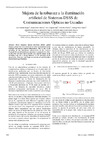Identificador persistente para citar o vincular este elemento:
https://accedacris.ulpgc.es/jspui/handle/10553/107354
| Campo DC | Valor | idioma |
|---|---|---|
| dc.contributor.author | Rabadán Borges, José Alberto | en_US |
| dc.contributor.author | Pérez Jiménez, Rafael | en_US |
| dc.contributor.author | Delgado-Rajó, Francisco A. | en_US |
| dc.contributor.author | Rufo Torres, Julio Francisco | en_US |
| dc.contributor.author | Pérez-Suárez, Santiago T. | en_US |
| dc.date.accessioned | 2021-05-31T08:56:16Z | - |
| dc.date.available | 2021-05-31T08:56:16Z | - |
| dc.date.issued | 2006 | en_US |
| dc.identifier.isbn | 84-611-2488-X | en_US |
| dc.identifier.uri | https://accedacris.ulpgc.es/handle/10553/107354 | - |
| dc.description.abstract | Direct Sequence Spread Spectrum (DSSS) optical wireless systems have been shown to be robust to interference from artificial and natural ambient illumination. This is due to the spreading of any interference photocurrent in the receiver. Normally the spread interference spectrum is assumed to be white.In this letter we show that is not the case, and the design of the spreading code has a strong influence on the spectrum of the spread noise. Rules for code design are introduced, and their effect demonstrated experimentally. | en_US |
| dc.language | spa | en_US |
| dc.source | Actas URSI'06, p. 1030-1033 | en_US |
| dc.subject | 3325 Tecnología de las telecomunicaciones | en_US |
| dc.title | Mejora de la robustez a la iluminación artificial de sistemas DSSS de comunicaciones ópticas no guiadas | en_US |
| dc.type | info:eu-repo/semantics/conferenceobject | en_US |
| dc.type | ConferenceObject | en_US |
| dc.relation.conference | XXI Simposium Nacional de la Unión Científica Internacional de Radio (URSI 2006) | en_US |
| dc.description.lastpage | 1033 | en_US |
| dc.description.firstpage | 1030 | en_US |
| dc.investigacion | Ingeniería y Arquitectura | en_US |
| dc.type2 | Actas de congresos | en_US |
| dc.identifier.eisbn | 978-84-611-2488-6 | - |
| dc.utils.revision | Sí | en_US |
| dc.date.coverdate | Septiembre 2006 | en_US |
| dc.identifier.ulpgc | Sí | en_US |
| dc.contributor.buulpgc | BU-TEL | en_US |
| item.fulltext | Con texto completo | - |
| item.grantfulltext | open | - |
| crisitem.author.dept | GIR IDeTIC: División de Fotónica y Comunicaciones | - |
| crisitem.author.dept | IU para el Desarrollo Tecnológico y la Innovación | - |
| crisitem.author.dept | Departamento de Señales y Comunicaciones | - |
| crisitem.author.dept | GIR IDeTIC: División de Fotónica y Comunicaciones | - |
| crisitem.author.dept | IU para el Desarrollo Tecnológico y la Innovación | - |
| crisitem.author.dept | Departamento de Señales y Comunicaciones | - |
| crisitem.author.dept | GIR IDeTIC: División de Redes y Servicios Telemáticos | - |
| crisitem.author.dept | IU para el Desarrollo Tecnológico y la Innovación | - |
| crisitem.author.dept | Departamento de Ingeniería Telemática | - |
| crisitem.author.dept | GIR IDeTIC: División de Fotónica y Comunicaciones | - |
| crisitem.author.dept | IU para el Desarrollo Tecnológico y la Innovación | - |
| crisitem.author.dept | Departamento de Señales y Comunicaciones | - |
| crisitem.author.orcid | 0000-0002-9994-4495 | - |
| crisitem.author.orcid | 0000-0002-8849-592X | - |
| crisitem.author.orcid | 0000-0002-7262-7633 | - |
| crisitem.author.orcid | 0000-0002-2269-6729 | - |
| crisitem.author.orcid | 0000-0001-5702-4773 | - |
| crisitem.author.parentorg | IU para el Desarrollo Tecnológico y la Innovación | - |
| crisitem.author.parentorg | IU para el Desarrollo Tecnológico y la Innovación | - |
| crisitem.author.parentorg | IU para el Desarrollo Tecnológico y la Innovación | - |
| crisitem.author.parentorg | IU para el Desarrollo Tecnológico y la Innovación | - |
| crisitem.author.fullName | Rabadán Borges, José Alberto | - |
| crisitem.author.fullName | Pérez Jiménez, Rafael | - |
| crisitem.author.fullName | Delgado Rajó, Francisco Alberto | - |
| crisitem.author.fullName | Rufo Torres,Julio Francisco | - |
| crisitem.author.fullName | Pérez Suárez, Santiago Tomás | - |
| crisitem.event.eventsstartdate | 12-09-2006 | - |
| crisitem.event.eventsenddate | 15-09-2006 | - |
| Colección: | Actas de congresos | |
Visitas
117
actualizado el 11-may-2024
Descargas
20
actualizado el 11-may-2024
Google ScholarTM
Verifica
Altmetric
Comparte
Exporta metadatos
Los elementos en ULPGC accedaCRIS están protegidos por derechos de autor con todos los derechos reservados, a menos que se indique lo contrario.
